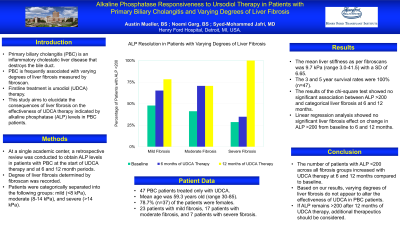Back


Poster Session B - Monday Morning
Category: Liver
B0509 - Alkaline Phosphatase Responsiveness to Ursodiol Therapy in Patients With Primary Biliary Cholangitis and Varying Degrees of Liver Fibrosis
Monday, October 24, 2022
10:00 AM – 12:00 PM ET
Location: Crown Ballroom

Has Audio

Austin Mueller, BS
Wayne State University School of Medicine
Detroit, MI
Presenting Author(s)
Austin Mueller, BS1, Noemi Garg, BS1, Syed-Mohammed Jafri, MD2
1Wayne State University School of Medicine, Detroit, MI; 2Henry Ford Health System, Detroit, MI
Introduction: Primary biliary cholangitis (PBC) is an inflammatory cholestatic liver disease that destroys the bile duct. PBC is frequently associated with varying degrees of liver fibrosis measured by fibroscan. Various mechanisms such as inflammation, cytokine signaling, and abnormal interaction amongst cholangiocytes and mesenchymal cells contribute to the development of fibrosis. Firstline treatment is ursodiol (UDCA) therapy. This study aims to elucidate the consequences of liver fibrosis on the effectiveness of UDCA therapy indicated by alkaline phosphatase (ALP) levels in PBC patients.
Methods: At a single academic center, a retrospective review was conducted to obtain ALP levels in patients with PBC at the start of UDCA therapy and at 6 and 12 month periods. Degree of liver fibrosis determined by fibroscan was recorded. Patients were categorically separated into the following groups: mild (< 8 kPa), moderate (8-14 kPa), and severe ( >14 kPa). Variables were analyzed by chi-squared tests and general linear regression analysis.
Results: In 47 PBC patients treated only with UDCA, the mean age was 59.3 years old (range 30-85). 78.7% (n=37) of the patients were females. The mean liver stiffness as per fibroscans was 9.7 kPa (range 3.0-41.5) with a SD of 6.65. The 3 and 5 year survival were both 100% (n=47).
48.9% (n=23) of patients had mild fibrosis, 36.2% (n=17) of patients had moderate fibrosis, and 14.9% (n=7) of patients had severe fibrosis. Regarding patients with mild fibrosis, ALP < 200 at baseline and at 6 and 12 months was 47.8%, 65.2%, and 78.3%, respectively. Regarding patients with moderate fibrosis, ALP < 200 at baseline and at 6 and 12 months was 41.2%, 70.6%, and 70.6%, respectively. Regarding patients with severe fibrosis, ALP < 200 at baseline and at 6 and 12 months was 28.6%, 34.8%, and 100%, respectively.
The results of the chi-square test showed no significant association between ALP >200 and categorical liver fibrosis at 6 and 12 months. Linear regression analysis showed no significant liver fibrosis effect on change in ALP >200 from baseline to 6 and 12 months.
Discussion: The number of patients with ALP < 200 across all fibrosis groups increased with UDCA therapy at 6 and 12 months compared to baseline. Based on our results, varying degrees of liver fibrosis do not appear to alter the effectiveness of UDCA in PBC patients. If ALP remains >200 after 12 months of UDCA therapy, additional therapeutics should be considered.
Disclosures:
Austin Mueller, BS1, Noemi Garg, BS1, Syed-Mohammed Jafri, MD2. B0509 - Alkaline Phosphatase Responsiveness to Ursodiol Therapy in Patients With Primary Biliary Cholangitis and Varying Degrees of Liver Fibrosis, ACG 2022 Annual Scientific Meeting Abstracts. Charlotte, NC: American College of Gastroenterology.
1Wayne State University School of Medicine, Detroit, MI; 2Henry Ford Health System, Detroit, MI
Introduction: Primary biliary cholangitis (PBC) is an inflammatory cholestatic liver disease that destroys the bile duct. PBC is frequently associated with varying degrees of liver fibrosis measured by fibroscan. Various mechanisms such as inflammation, cytokine signaling, and abnormal interaction amongst cholangiocytes and mesenchymal cells contribute to the development of fibrosis. Firstline treatment is ursodiol (UDCA) therapy. This study aims to elucidate the consequences of liver fibrosis on the effectiveness of UDCA therapy indicated by alkaline phosphatase (ALP) levels in PBC patients.
Methods: At a single academic center, a retrospective review was conducted to obtain ALP levels in patients with PBC at the start of UDCA therapy and at 6 and 12 month periods. Degree of liver fibrosis determined by fibroscan was recorded. Patients were categorically separated into the following groups: mild (< 8 kPa), moderate (8-14 kPa), and severe ( >14 kPa). Variables were analyzed by chi-squared tests and general linear regression analysis.
Results: In 47 PBC patients treated only with UDCA, the mean age was 59.3 years old (range 30-85). 78.7% (n=37) of the patients were females. The mean liver stiffness as per fibroscans was 9.7 kPa (range 3.0-41.5) with a SD of 6.65. The 3 and 5 year survival were both 100% (n=47).
48.9% (n=23) of patients had mild fibrosis, 36.2% (n=17) of patients had moderate fibrosis, and 14.9% (n=7) of patients had severe fibrosis. Regarding patients with mild fibrosis, ALP < 200 at baseline and at 6 and 12 months was 47.8%, 65.2%, and 78.3%, respectively. Regarding patients with moderate fibrosis, ALP < 200 at baseline and at 6 and 12 months was 41.2%, 70.6%, and 70.6%, respectively. Regarding patients with severe fibrosis, ALP < 200 at baseline and at 6 and 12 months was 28.6%, 34.8%, and 100%, respectively.
The results of the chi-square test showed no significant association between ALP >200 and categorical liver fibrosis at 6 and 12 months. Linear regression analysis showed no significant liver fibrosis effect on change in ALP >200 from baseline to 6 and 12 months.
Discussion: The number of patients with ALP < 200 across all fibrosis groups increased with UDCA therapy at 6 and 12 months compared to baseline. Based on our results, varying degrees of liver fibrosis do not appear to alter the effectiveness of UDCA in PBC patients. If ALP remains >200 after 12 months of UDCA therapy, additional therapeutics should be considered.
Disclosures:
Austin Mueller indicated no relevant financial relationships.
Noemi Garg indicated no relevant financial relationships.
Syed-Mohammed Jafri indicated no relevant financial relationships.
Austin Mueller, BS1, Noemi Garg, BS1, Syed-Mohammed Jafri, MD2. B0509 - Alkaline Phosphatase Responsiveness to Ursodiol Therapy in Patients With Primary Biliary Cholangitis and Varying Degrees of Liver Fibrosis, ACG 2022 Annual Scientific Meeting Abstracts. Charlotte, NC: American College of Gastroenterology.
